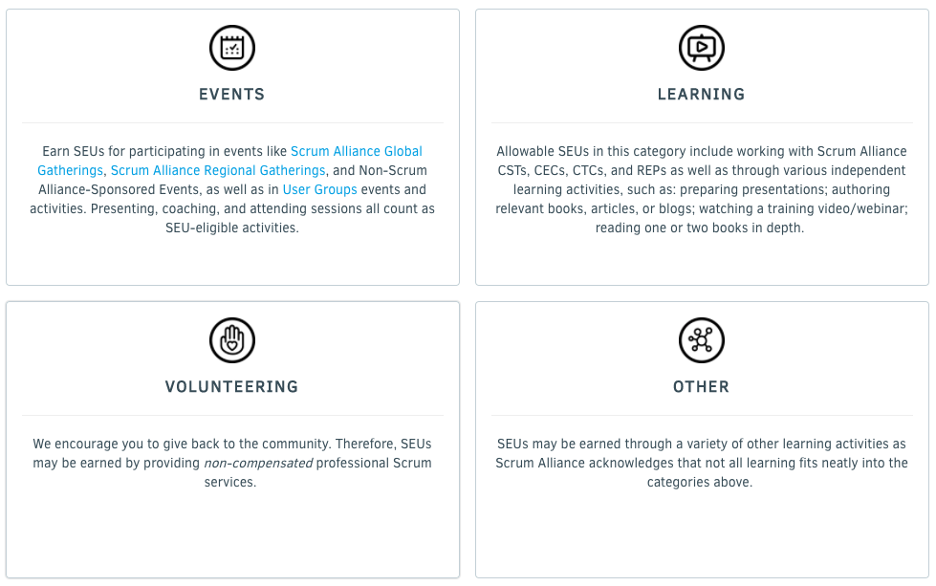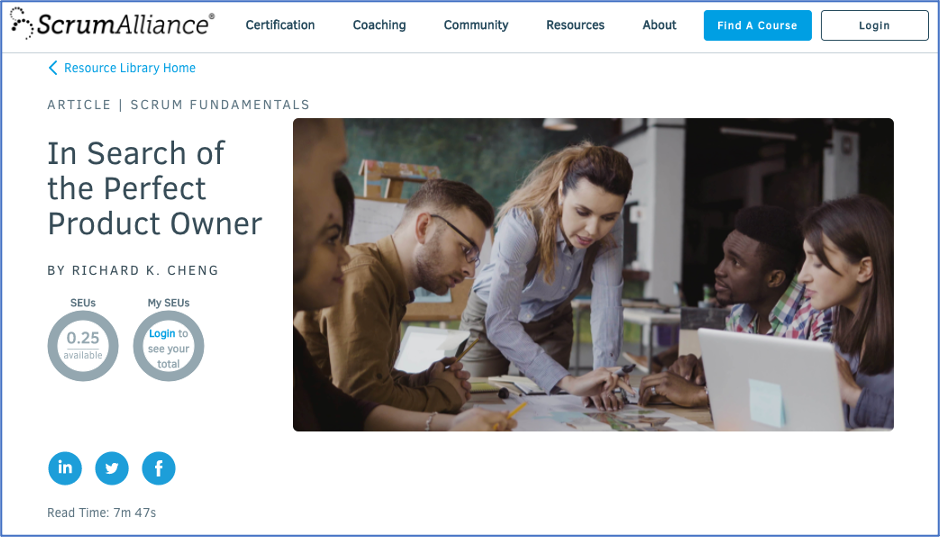If you have a Scrum Alliance certification, your certification is good for two years. Then, you can renew your certification, a process that involves paying a renewal fee and collecting Scrum Education Units (SEUs) to prove your Scrum prowess. Each hour of your continuing education — the time you spend reading articles, volunteering, attending events, and taking courses — equals one Scrum Education Unit (SEU).

Figure 1 – ScrumAlliance renewal requirements
In addition to needing SEUs to renew you Scrum Alliance certifications, SEUs are a great way to track your continued learning and growth in Scrum concepts. Your Scrum journey doesn’t stop with the training and certification. SEUs help you create a plan to continue growing in your Agile expertise. By working through SEUs, you can hear other perspectives, learn new concepts, practice concepts you have learned, and demonstrate advanced critical thinking into Scrum concepts.
How to obtain SEUs:
You can obtain SEUs from a variety of ways (see Figure 2). Some options include:
- Attending conferences and events (in-person or virtual)
- Attending training (in-person or virtual)
- Self-guided study
- Volunteering
- Certain aspects of day-to-day work

Figure 2 – From ScrumAlliance
Ideas for collecting SEUs:
- Since SEUs are gained at a rate of one SEU per hour spent, attending a daylong or multi-day event is a great way to gain multiple SEUs. The great thing is that many virtual events are free or charge a very low rate. For example, if you attended the Scrum Alliance Product Ownership Beyond the Classroom virtual event, the cost was $35 and the event consists of two half-day sessions for a total of 8 SEUs
- Webinars and user group meetings are not only eligible for SEUs, they’re also typically free. This includes NextUp’s webinar series. Many user groups are grassroots, community driven efforts so you get to support the local Scum community, freshen up on Agile topics, and get SEUs.
- You can get SEUs just from reading and researching topics related Agile and Scrum through your own self-guided study. If you read articles directly from the ScrumAlliance website, they often tell you how many SEUs you get. For example, I wrote a short article for the ScrumAlliance; as you can see, it shows that you can claim .25 SEUs for reading it.
- Give back! Volunteer work counts toward SEUs. For example, if you serve as a ScrumMaster to help a team at a local charity, you can count those hours (and feel good about your contribution).
- Lastly, if you attend a training class, you can claim those hours. Here’s the trick: if you attend a ScrumAlliance training course that leads to a ScrumAlliance certification, that will automatically renew and reset your other ScrumAlliance certifications. For example, if you became a Certified ScrumMaster (CSM) 18 months ago, and then took a Certified Scrum Product Owner (CSPO) course and became a CSPO, then your CSM automatically renews to match your CSPO date and you don’t need to claim SEUs or pay the $100 for the CSM renewal fee. On your new two-year renewal date, you pay the $100 and the claim the 20 SEUs which would then cover both the CSM and CSPO certifications. All of NextUp Solutions’ classes count towards SEUs and attending our ScrumAlliance certified classes automatically renews your existing ScrumAlliance certifications.

Figure 3 – ScrumAlliance article with SEUs shown
For more information on SEUs, the ScrumAlliance has some great resources: